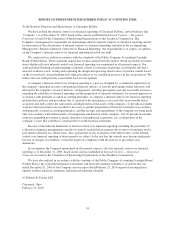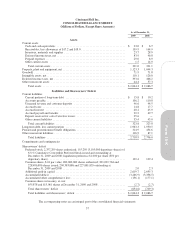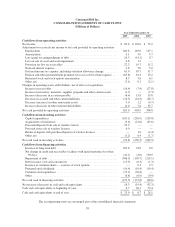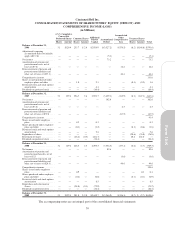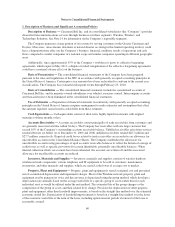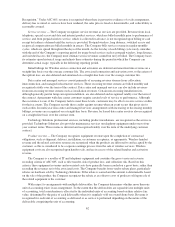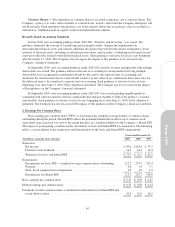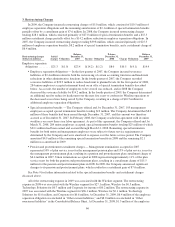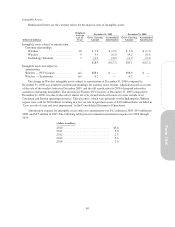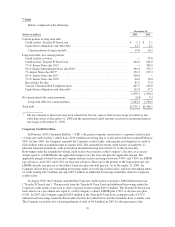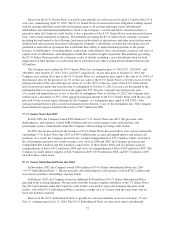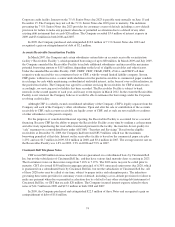Cincinnati Bell 2009 Annual Report Download - page 134
Download and view the complete annual report
Please find page 134 of the 2009 Cincinnati Bell annual report below. You can navigate through the pages in the report by either clicking on the pages listed below, or by using the keyword search tool below to find specific information within the annual report.Stock-Based Compensation — The Company values all share-based payments to employees at fair value
on the date of grant and expenses this amount over the applicable vesting period. The fair value of stock options
and stock appreciation rights is determined using the Black-Scholes option-pricing model using assumptions
such as volatility, risk-free interest rate, holding period and dividends. The fair value of stock awards is based on
the Company’s closing share price on the date of grant. For all share-based payments, an assumption is also made
for the estimated forfeiture rate based on the historical behavior of employees. The forfeiture rate reduces the
total fair value of the awards to be recognized as compensation expense. The Company’s policy for graded
vesting awards is to recognize compensation expense on a straight-line basis over the vesting period. The
Company also has granted employee awards to be ultimately paid in cash which are indexed to the change in the
Company’s common stock price. These liability awards are marked to fair market value at each quarter-end, and
the adjusted fair value is expensed on a pro-rata basis over the vesting period. Refer to Note 13 for further
discussion related to stock-based and deferred compensation plans.
Employee Benefit Plans — As more fully described in Note 9, the Company maintains qualified and
non-qualified defined benefit pension plans, and also provides postretirement healthcare and life insurance
benefits for eligible employees. The Company recognizes the overfunded or underfunded status of its defined
benefit pension and other postretirement benefit plans as either an asset or liability in its Consolidated Balance
Sheets and recognizes changes in the funded status in the year in which the changes occur as a component of
comprehensive income. Pension and postretirement healthcare and life insurance benefits earned during the year
and interest on the projected benefit obligations are accrued and recognized currently in net periodic benefit cost.
Prior service costs and credits resulting from changes in management postretirement plan benefits are amortized
over the average life expectancy of the participants while management pension plan benefits and
non-management plan benefits are amortized over the average remaining service period of the employees
expected to receive the benefits. Net gains or losses resulting from differences between actuarial experience and
assumptions or from changes in actuarial assumptions are recognized as a component of annual net periodic
benefit cost. Unrecognized actuarial gains or losses that exceed 10% of the projected benefit obligation are
amortized on a straight-line basis over the average remaining service life of active employees (approximately 15
years).
Termination Benefits — The Company has written severance plans covering both its management and
union employees and, as such, accrues probable and estimable employee separation liabilities in accordance with
ASC 712. These liabilities are based on the Company’s historical experience of severance, historical costs
associated with severance, and management’s expectation of future severance.
The Company accrues for special termination benefits upon acceptance by an employee of any voluntary
termination offer and determines if the employee terminations give rise to a pension and postretirement
curtailment charge in accordance with ASC 715. The Company’s policy is that terminations in a calendar year
involving 10% or more of the plan future service years will result in a curtailment of the pension or
postretirement plan. See Note 3 for further discussion of the Company’s restructuring plans.
Derivative Financial Instruments — The Company is exposed to the impact of interest rate fluctuations on
its indebtedness. The Company periodically employs derivative financial instruments to manage its balance of
fixed rate and variable rate indebtedness. The Company does not hold or issue derivative financial instruments
for trading or speculative purposes. Interest rate swap agreements, a particular type of derivative financial
instrument, involve the exchange of fixed and variable rate interest payments and do not represent an actual
exchange of the notional amounts between the parties. At December 31, 2008, the Company had long-term
interest rate swaps that qualified as fair value hedges and were accounted for in accordance with ASC 815. Fair
value hedges offset changes in the fair value of underlying assets and liabilities. All of the long-term interest rate
swaps held at December 31, 2008 were terminated or called in 2009.
The realized gain or loss on a terminated interest rate swap contract that was designated as a fair value
hedge is amortized to “Interest expense” in the Consolidated Statements of Operations over the remaining term
of the underlying hedged item.
The Company also held short-term interest rate swap contracts as of December 31, 2008, which were not
designated as hedging instruments under ASC 815. As a result, the change in the fair value of these instruments
was recognized in net income during each period that these instruments were outstanding in “Other expense
(income), net” on the Consolidated Statement of Operations.
64


